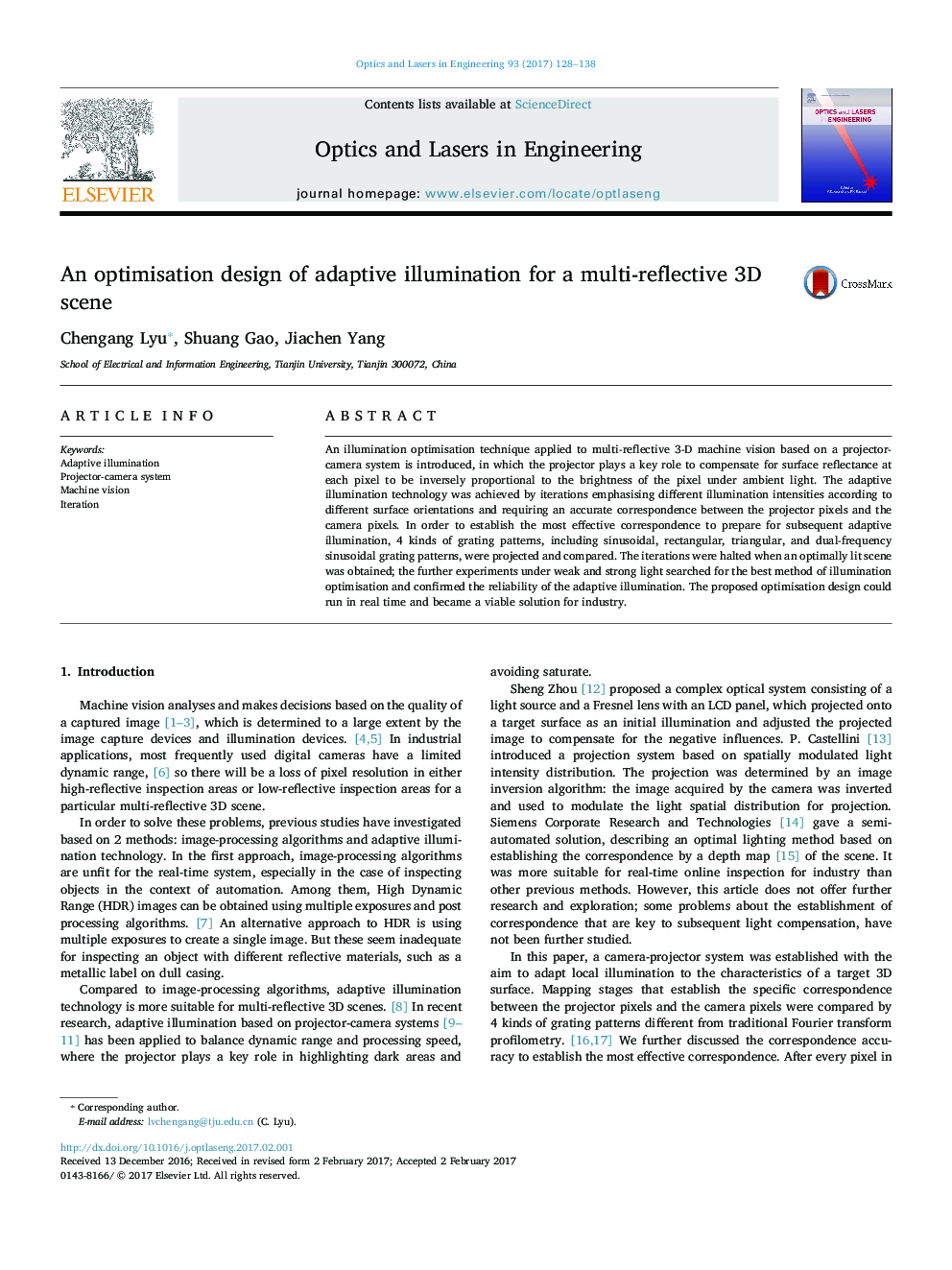| کد مقاله | کد نشریه | سال انتشار | مقاله انگلیسی | نسخه تمام متن |
|---|---|---|---|---|
| 5007780 | 1461700 | 2017 | 11 صفحه PDF | دانلود رایگان |
عنوان انگلیسی مقاله ISI
An optimisation design of adaptive illumination for a multi-reflective 3D scene
ترجمه فارسی عنوان
طراحی بهینه سازی نورپردازی انطباقی برای یک صحنه سه بعدی چند بعدی
دانلود مقاله + سفارش ترجمه
دانلود مقاله ISI انگلیسی
رایگان برای ایرانیان
کلمات کلیدی
نورپردازی سازگار، سیستم دوربین پروژکتور بینایی ماشین، تکرار،
ترجمه چکیده
یکی از روشهای بهینه سازی نورپردازی، به وسیله یک سیستم دوربین پروژکتور چند منظوره بازتابنده طراحی شده است که در آن پروژکتور یک نقش کلیدی برای جبران بازتابی سطح در هر پیکسل دارد که نسبتا متناسب با روشنایی پیکسل است تحت نور محیط تکنولوژی روشنایی سازگار با تکرارهایی که بر شدت نورهای مختلف با توجه به جهت گیری های مختلف سطحی تاکید دارد و نیاز به مکاتبات دقیق بین پیکسل های پروژکتور و پیکسل های دوربین دارد. به منظور ایجاد مؤثر ترین مکاتبات برای آماده سازی برای روشنایی انطباق پذیری بعدی، 4 نوع الگوهای گریت، از جمله الگوهای سینوسی، مستطیلی، مثلثی و فرکانس سینوسی دوگانه، پیش بینی شده و مقایسه شده است. تکرارها زمانی که یک صحنه بهینه به دست می آمد، متوقف شد؛ آزمایش های بیشتر در نور ضعیف و قوی برای بهترین روش برای بهینه سازی نور جستجو کرد و قابلیت اطمینان روشنایی سازگار را تایید کرد. طرح پیشنهادی بهینه سازی می تواند در زمان واقعی اجرا شود و یک راه حل مناسب برای صنعت باشد.
موضوعات مرتبط
مهندسی و علوم پایه
سایر رشته های مهندسی
مهندسی برق و الکترونیک
چکیده انگلیسی
An illumination optimisation technique applied to multi-reflective 3-D machine vision based on a projector-camera system is introduced, in which the projector plays a key role to compensate for surface reflectance at each pixel to be inversely proportional to the brightness of the pixel under ambient light. The adaptive illumination technology was achieved by iterations emphasising different illumination intensities according to different surface orientations and requiring an accurate correspondence between the projector pixels and the camera pixels. In order to establish the most effective correspondence to prepare for subsequent adaptive illumination, 4 kinds of grating patterns, including sinusoidal, rectangular, triangular, and dual-frequency sinusoidal grating patterns, were projected and compared. The iterations were halted when an optimally lit scene was obtained; the further experiments under weak and strong light searched for the best method of illumination optimisation and confirmed the reliability of the adaptive illumination. The proposed optimisation design could run in real time and became a viable solution for industry.
ناشر
Database: Elsevier - ScienceDirect (ساینس دایرکت)
Journal: Optics and Lasers in Engineering - Volume 93, June 2017, Pages 128-138
Journal: Optics and Lasers in Engineering - Volume 93, June 2017, Pages 128-138
نویسندگان
Chengang Lyu, Shuang Gao, Jiachen Yang,
